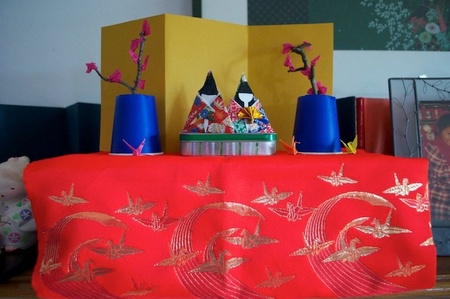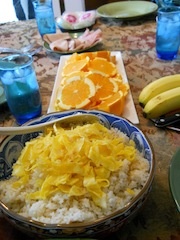Girls’ Day at our house this year meant pink and green mochi, a box stand with Emperor and Empress origami dolls, and a stack of oatmeal pancakes.
Our improvised Hina Matsuri began a few years ago. “Can we celebrate Girls’ Day?” asked my sister-friend Bryn—who is not Japanese or Japanese American, but loves this tradition nevertheless. She knew I still had my yukata, made just for me, from our relatives in Japan; she knew the girls still love to wear it. Growing up in Kansas, Bryn had read about Girls’ Day from The Japanese Twins, a book published in 1911. She brought a copy for my daughters, so they could read about it. We had my yukata; we could find out more of the rest. “Sure!” I replied blithely.
Being a good straight-A student, I did my research. We had one picture book about Girls’ Day, for kids in Hawai’i. I looked at different pictures and online tutorials, and began to work on the doll display. I had craft supplies to make the dolls: fancy gilt origami paper for the robes, black crepe paper for the hair, and small cardboard circles with necks for the heads. We draped a remnant of red obi fabric, embroidered with golden cranes, over a black cardboard box. We also needed a couple of blossoming trees, so I took some tiny mossy branches from our apple tree, glued some bits of pink tissue paper, and placed them in upside-down paper cups. In perhaps my proudest Pinterest craft-moment ever, I turned a green Altoid tin upside down and made it into the stand for the dolls. Then I printed out a couple of pages from the Internet, with Emperor and Empress figures for the girls to color while they were waiting for breakfast. I’d made pans of coconut mochi in college for my Japanese American student club, so we made that the night before. That morning I made some rice and added some tamago. It was brunch, and I love making oatmeal pancakes, so we added those to the menu.
Ceremonial dolls, check; symbolic foods, check. That morning, I didn’t know what to say to the girls, except “Happy Girls’ Day!” My husband Josh, who’s better at saying these things, told his daughters how proud he was of them. We invited our niece to celebrate with us, as well as her parents, because I want the girls to know something that my Filipina grandmother taught me: holidays are for celebrating with family. We wrote down a few things that we hoped for each girl and sealed them up in an envelope, to be opened when the girls are older.
So why celebrate? Part of the answer lies in presence: the desire to be connected with family, with some of the intentions of Girls’ Day: a day to wish the girls happiness in their futures: a day to sit around a table and share food.
* * * * *
And yet part of why we celebrate Girls’ Day also lies in distance. I’m thinking about the distance from my Japanese American grandmother, who I never really knew because she died when I was a toddler. I never celebrated Girls’ Day when I was growing up, so I’m slightly envious of cities where Japanese American kids can go to see large displays of Girls’ Day dolls, practice with Girls’ Day crafts. We do live near Seattle, which has several vibrant Japanese American communities in and near the city, but I have felt more Asian American than Japanese American in the Pacific Northwest. The Wing Luke Asian Museum and the Asia Pacific Cultural Center are inclusive, and both focus on a pan-Asian American identity. I am comforted when I think about how Girls’ Day was originally a private celebration, a ritual of family bonding at home.
We’re waiting now for the summer, which will bring us the arrival of the Nimura family Girls’ Day dolls. According to my Auntie Sadako, my grandfather purchased them for my oldest auntie, my auntie Hisa, after they lost their first infant daughter. (“Hisa” means “long life.”) My oldest auntie never had daughters, and the set passed to the next oldest daughter, my auntie Sadako. My auntie Sadako did not have daughters either, but she is leaving the set of dolls to me and my daughters, as well as the stand my uncle made for the set. I have a picture of me and my sister, posed in front of that doll display. I can’t wait to see my daughters posed in front of the display too.
After three years of making up Girls’ Day as I go along, I’ve come to feel a little better about how we celebrate it. Unlike my family’s Oshogatsu celebration, which has decades of repetition (and variation) behind it, this Girls’ Day is a new tradition that we are creating for our daughters. Like pop music, it needs to wear a groove in the mind before it is meaningful—traditions need time, loss, and renewal before love.
What’s going to stay? The dolls? The mochi? What will change? The pleasure of tradition lies in the echoes, in the resonance. Part of celebrating Girls’ Day lies in my attempt to bridge the distance between my family and a Japanese American community, in my attempt to bridge my past with my present and my family’s past with our present.
* * * * *
If I really ask myself why we celebrate Girls’ Day, a more difficult answer lies in a Tacoma park, on a cold sunny day a couple of years ago. My oldest daughter Ella is playing with some older boys on a rotating jungle gym. She is 6 years old, and just strong enough to begin pushing part of it by herself. Then somehow my ear catches this part of their conversation.
Boy: Oh, the Japanese! They’re taking over our country!
Boy’s mother: Brian, don’t say that. There might be some Japanese people around here.
Ella: Yeah! My mom’s Japanese. She’s right over there. See?
Inside the pockets of my wool coat, my hands clench into fists. I am the fourth-grader watching “The Mikado,” confused by “Japanese” people dressed in kimonos with bizarre names like Yum-Yum and Nanki-Poo. I am the seventh-grader who’s walking by some boys stretching their eyelids into brown slits, “chingchongchinaman”, to which I can only respond to by flipping them off and walking away quickly. I am the grad student visiting the “Roots of Racism” exhibit in Knoxville, Tennessee, who can only respond with a shocked silence when the docent at the entrance desk jokes, “No tickee, no laundry”. I was never the quick-witted comeback kid.
At the Tacoma playground, there is surprise that this narrative of feared Asian dominance is still floating around; anger that my daughter has to negotiate something like this at six years old; even more anger that the parent doesn’t know any other way to confront the racism she has passed onto her son then to varnish their bigotry with a veneer of shabby politeness. There’s dark humor that the kid’s bigotry appears some thirty years late: the 1980s called, kid, and it wants its racism back.
Standing at the core, though, there is a stubborn pride that my daughter isn’t ashamed of identifying me as Japanese. She doesn’t laugh or go along with the slur. She claims me and her Japanese-ness as part of who she is.
Even in a multicultural country like ours, even in a supposedly liberal and Asian American area like the Pacific Northwest, the significance of a Girls’ Day tradition lies not only in its resonance but in its resistance. There are going to be so many forms of misrepresentation, Katy Perry performances, and “Mikado” restagings that tell my daughters what it is to be Japanese. I want to give them a broader, rooted sense of what it is to be Japanese and Japanese American. Part of that sense lies in community spaces, but part of that must also begin at home.
Traditionally, we’re supposed to take the doll display down right after Girls’ Day—this part of the tradition involves diminishing marriage prospects, the longer the dolls are on display.
“Can’t we keep the dolls up a little while longer?” the girls ask. I can’t refuse.
© 2014 Tamiko Nimura







